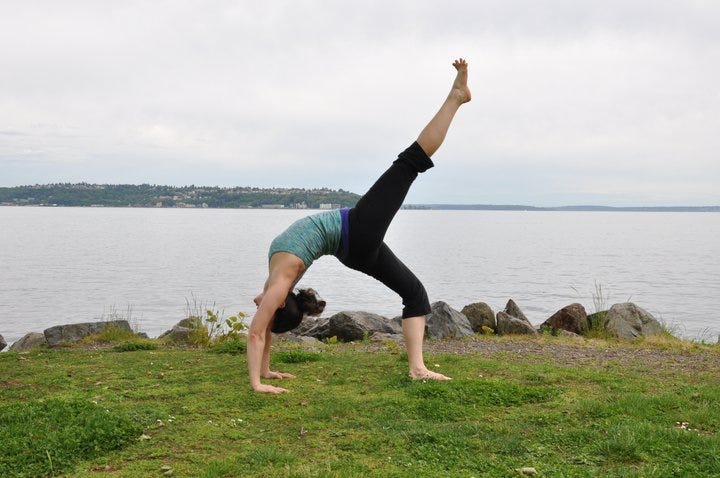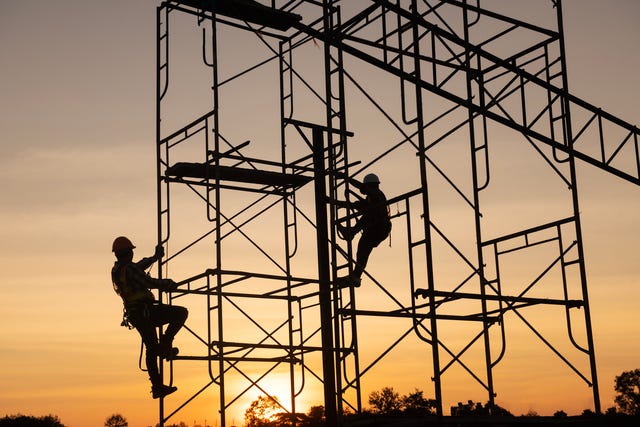Scaffolding, please!
How a hidden condition common to ADHD/ASD can undermine daily life and mental wellbeing
Dear Nurturing Neurospicy Mamas reader: thanks for supporting my Substack! This is a space to share personal stories and build community - in particular around themes of late-diagnosed neurodiversity, mid-life identity transitions, parenting, and self care/movement practices. As it builds, I’ll be adding reflective articles, pieces on my fictional writing projects, poetry, and guest/collaborative articles. I currently publish 1-2 posts per week. My intention is to keep all content free for the first month. I envision some special offerings for paid subscribers, such as a movement-focused series and video content.
A couple weeks ago, exhausted after standing for a few hours at a Girl Scout cookie booth, I collapsed on the couch to snuggle with my four-year-old and watch a few episodes of Bluey. Not having slept well the night before because he had been up wandering the house at 1 a.m., I drifted into a cozy sleep. My neck was propped up at a weird angle, but I didn’t care. I was drugged with sleepy bliss. A ten-minute snooze soon turned into 90 minutes.
I woke up with a little crick in my neck. By the next day, it had turned into a full-blown neck and shoulder impingement, shooting pain down my arm and back and up the side of my neck. It was time to head back to the chiropractor for more TLC.
This joint issue has been a literal pain in my neck since January 2020. A teen driver ran a stop sign and plowed into me at 30 MPH when I was 20 weeks pregnant. He crushed the passenger door behind me, spinning the car 180 degrees and throwing it up onto the curb. Our Subaru Crosstrek was totaled, but thanks to the side airbag and other safety features, baby and I were ok. The one lasting issue: my neck. Even after months of massage and chiropractic, it’s never quite been the same.
Joint problems are not a new thing for me. At 35, I had foot surgery to try to correct a bone spur that grew over several years because my toes weren’t well-aligned. Years of long distance running in my youth and early twenties without focusing on core or hip strength led to foot issues as well as knee pain and early arthritis in my lower back and neck. Even after switching to lower impact activities in my late 20s, I still had a lot of ongoing joint pain and problems with weird things like ribs popping out of place.
As I shifted to gentler exercise activities in my 20s, I discovered yoga. When I moved to the Pacific Northwest in 2008, I found a new religion of sorts: heated power yoga. These classes became an everyday activity, and I latched on with what became cult-like devotion. Strengthening my core and hips, combined with detoxification through sweat and an anti-inflammatory diet, brought a level of health I’d never experienced before.
In my early 30s, I decided to take this journey a step further and become a yoga instructor. My high level of bendiness meant I was “good” at yoga poses often considered difficult by many practitioners. Stretchy poses like eagle and backbends like wheel pose came easily for me.
I was surprised to discover that my natural flexibility wasn’t actually perceived by the teacher training instructors as a positive. For starters, I learned, there is no such thing as being “good” at yoga. But also, the goal of yoga is to stretch the muscles, not the connective tissue, as I had been doing. Stretching ligaments is not a good thing, it turns out.
With coaching and support, I gradually retrained my body to rely on muscle strength instead of joint mobility. As I discovered how to use my core more effectively, the wear and tear on my joints slowed. I could practice yoga without hurting myself, thanks to heightened focus on alignment and building resilient stabilizing muscles. As I taught new students yoga poses, I was a stickler about good alignment, avoiding locking out joints, and engaging the core.
Recently, at the recommendation of a good friend, I picked up an autobiography called Floppy: Tales of a Genetic Freak of Nature at the End of the World. In this memoir, author Alyssa Graybeal describes her experience with Ehlers-Danlos Syndrome (EDS). The EDS Society’s website notes that these syndromes “are a group of 13 heritable connective tissue disorders…caused by genetic changes that affect connective tissue. Each type of EDS has its own set of features with distinct diagnostic criteria. Some features are seen across all types of EDS, including joint hypermobility, skin hyperextensibility, and tissue fragility.”
As she camouflaged her true self and adapted to a world that did not understand or acknowledge her hidden disability and associated needs, Graybeal’s humorous and self-aware musings hit home. Though I doubt I have full-blown EDS, I’m quite certain that I’m somewhere on the hypermobility spectrum.
For overly bendy folks, the world can feel like a lot. Standing in one place for a long period of time can be excruciating. Repetitive actions, if not done with excellent body awareness, muscle engagement, and mindfulness, might result in dislocations, subluxations, and eventually long-term joint pain and injury. Many of us also aren’t great at proprioception – knowing where our bodies are in space. This can lead to a propensity toward “clumsiness” and accidents.
As I was conceptualizing this post, I came across a fascinating conversation with Dr. Jessica Eccles, PhD., on the podcast ADHD Chatter. Dr. Eccles, herself a person with AuDHD and hypermobility, studies the intersection of neuroscience, neurodivergence, mechanisms of chronic pain and fatigue, and psychiatric and neurodevelopmental features of connective tissue disorders.
Dr. Eccles’ research has uncovered a strong link between neurodiversity – both ASD and ADHD – and hypermobility spectrum disorder. This link is so strong that recent research showed close to 80 percent of women with ADHD studied were also hypermobile. Dr. Eccles talks about how neurodiverse conditions involve not only the brain but the entire body, and while they can manifest in many forms, these often include connective tissue differences. And these tissue differences understandably map to differences in how our bodies process sensory input.
Later in the podcast, Dr. Eccles talks about how new research is showing that anxiety stemming from these differences may be triggered by poor proprioception, given the brain center controlling proprioception is smaller in people with ADHD. Proprioception capacity, however, can be strengthened by therapies such as physiotherapy and sensory integration with an experienced physical or occupational therapist. Recent studies showed that effective therapy could reduce anxiety in a marked way.
Hearing this, lightbulbs went off in my head. This explained why alignment-focused, strength-based yoga has been so effective in calming my anxiety and reducing the negative mental chatter amplified by ADHD. Using a block and other yoga props for support has become second nature to me – to support and modify poses with the intention of building strength rather than flexibility alone. This scaffolding is what’s made yoga helpful for this bendy body.
My mind goes, too, to my own children, who thrive with yoga-type exercises and activities like swinging on monkey bars and playing Twister. Beyond the physical, though, these kids also need scaffolding support to manage daily household activities and build emotional resilience. As a harried, full-time working mom with ADHD myself, providing this type of support can seem like a lot. But without the scaffolding, clear expectations, and consistent consequences of authoritative parenting, my kids fall apart within the vacuum of boundaries.
Authoritative parenting, and setting and maintaining boundaries in general — do not come naturally to me. My erratic work schedule, ADHD-fueled resistance of routines and consistency, ADHD partner with similar proclivities, rejection sensitivity, and people-pleasing tendencies are not helpful. But my kids need these things.
What I do know is this: When I set up the physical scaffolding for myself, through a consistent and supportive yoga and strength training practice, I’m better able to manage my own anxiety and provide the emotional scaffolding for my kids. And this is no small thing.
As I learn more, my resolve to continue building and maintaining a physical and emotional self-care practice, as I develop authoritative parenting skills, has never been stronger. Perhaps this is a topic for a future post / discussion (and I would welcome tips from other neurodiverse parents on how you manage all of this within households that are 100% ND!)
This post is free, but if you enjoyed it and would like to support my writing you can:
❤️ Like my post
💡 Leave me a (constructive) comment
💌 Share, recommend, or restack this post
☕️ Buy me a virtual coffee
💵 Become a paid subscriber






The link between ND and hypermobility is wild, I can see how thinks like ADHD and dyslexia would come hand in hand but being more likely to be extra bendy is a new one.
My daughter has been under assessment for 8 years for ASD and 3 for ADHD and she's really bendy, dancer and always flipping and spinning etc. She's had some wrist issues this past year with no obvious cause and whilst I'm only 1% wiser than I was 5 minutes ago, I think it's probably worth considering that thing that you talked about but I can't remember what it's called because I'm commenting on a separate page. 🤦♂️ I'll have to bookmark this to come back to.
Thank you for such a well written and insightful post!